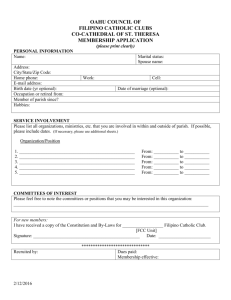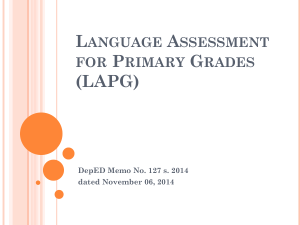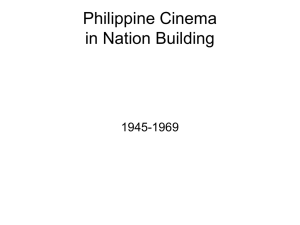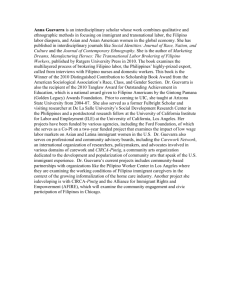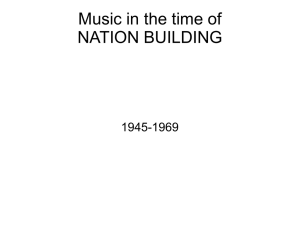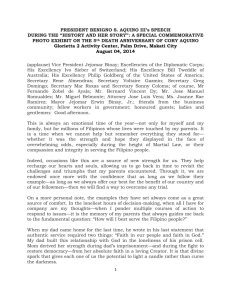Role of University – Based Language Organizations in Philippine
advertisement
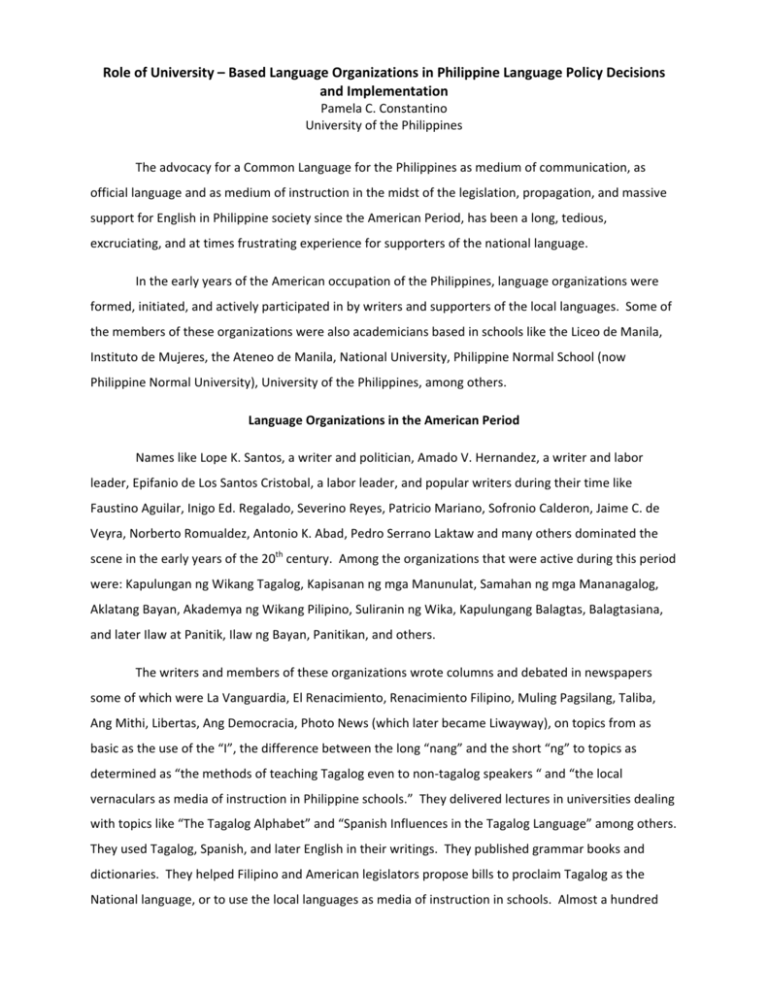
Role of University – Based Language Organizations in Philippine Language Policy Decisions and Implementation Pamela C. Constantino University of the Philippines The advocacy for a Common Language for the Philippines as medium of communication, as official language and as medium of instruction in the midst of the legislation, propagation, and massive support for English in Philippine society since the American Period, has been a long, tedious, excruciating, and at times frustrating experience for supporters of the national language. In the early years of the American occupation of the Philippines, language organizations were formed, initiated, and actively participated in by writers and supporters of the local languages. Some of the members of these organizations were also academicians based in schools like the Liceo de Manila, Instituto de Mujeres, the Ateneo de Manila, National University, Philippine Normal School (now Philippine Normal University), University of the Philippines, among others. Language Organizations in the American Period Names like Lope K. Santos, a writer and politician, Amado V. Hernandez, a writer and labor leader, Epifanio de Los Santos Cristobal, a labor leader, and popular writers during their time like Faustino Aguilar, Inigo Ed. Regalado, Severino Reyes, Patricio Mariano, Sofronio Calderon, Jaime C. de Veyra, Norberto Romualdez, Antonio K. Abad, Pedro Serrano Laktaw and many others dominated the scene in the early years of the 20th century. Among the organizations that were active during this period were: Kapulungan ng Wikang Tagalog, Kapisanan ng mga Manunulat, Samahan ng mga Mananagalog, Aklatang Bayan, Akademya ng Wikang Pilipino, Suliranin ng Wika, Kapulungang Balagtas, Balagtasiana, and later Ilaw at Panitik, Ilaw ng Bayan, Panitikan, and others. The writers and members of these organizations wrote columns and debated in newspapers some of which were La Vanguardia, El Renacimiento, Renacimiento Filipino, Muling Pagsilang, Taliba, Ang Mithi, Libertas, Ang Democracia, Photo News (which later became Liwayway), on topics from as basic as the use of the “I”, the difference between the long “nang” and the short “ng” to topics as determined as “the methods of teaching Tagalog even to non‐tagalog speakers “ and “the local vernaculars as media of instruction in Philippine schools.” They delivered lectures in universities dealing with topics like “The Tagalog Alphabet” and “Spanish Influences in the Tagalog Language” among others. They used Tagalog, Spanish, and later English in their writings. They published grammar books and dictionaries. They helped Filipino and American legislators propose bills to proclaim Tagalog as the National language, or to use the local languages as media of instruction in schools. Almost a hundred bills were introduced but none of which were approved by the American government. These writers also actively published poems, short stories, and novels (serialized) in newspapers carrying their pseudonyms. During the Commonwealth Period (1930s) which characterizes the Filipinization Program of the American government in the Philippines, most of these writers either joined the newspaper, the government, or the Universities. It was during this period (1935) that the Constitution of the Philippines was ratified. Article XIV, Section 3 of the Constitution provides that The National Assembly shall take steps toward the development and adoption of a common national language based on one of the existing Philippine Languages. Subsequently, the National Language Institute1 was formed as mandated by Commonwealth Act no. 184 to implement the Constitutional provision on language. This institute was to recommend to the President a national language based on one of the existing Philippine Languages, after a thorough research and a survey. After the proclamation, a dictionary and grammar should be published and used in public and private schools when the language would be taught in schools. All these were done and in 1940, the Filipino National Language (which was later called Pilipino in 1959) 2was taught in schools. (Cruz 1975 pp. 80‐82) The National Language In The 1973 and 1987 Constitutions The advocacy for a national language did not end with the proclamation of a national language for the Filipinos through the constitutional provision on language and its subsequent implementation. On the other hand, it triggered more issues and debates resulting in court cases, fora, newspaper columns, letters to the editor, talk shows, magazine articles, seminars. The 1973 and 1987 Constitution attempted to soften the stand of anti‐Pilipino or anti‐Tagalog with the adoption of Filipino. It was perceived that Pilipino is nothing but Tagalog. The visayans and other ethnolinguistic groups could not accept this “reality.” The visayans felt and still feels that there are more Visayans than Tagalogs, thus making their language more eligible to be the national language. The provision of the 1987 Constitution (Art. XIV, Sec. 6) categorically states that 1 This later became the Institute of National Language or Surian ng Wikang Pambansa, then became the Commission on Philippine Languages, and now called the Komisyon ng Wikang Filipino 2 Through Department of Education Order No. 7 2 The national language of the Philippines is Filipino. As it evolves, it shall be further developed and enriched on the basis of existing Philippine and other languages. Subject to provisions of law as the Congress may deem appropriate, the Government shall take steps to initiate and sustain the use of Filipino as a medium of official communication and as language of instruction in the educational system. The 1973 Constitution was not as categorical and specific (Art. XV, Sec. 3) The National Assembly shall take steps towards the development and formal adoption of a common national language to be known as Filipino. It was presumed that the use of the term “Filipino” would appease the non‐Tagalogs in their sentiment against Tagalog. “Filipino” now would represent the more or less 100 Philippine Languages, including Tagalog. However, even with the change of the Filipino alphabet from 20 letters to 28 letters to accommodate the sounds from Philippine Languages, English and Spanish, some groups still doubt the sincerity of the proponents of this language. They fear that it was just a political accommodation or strategy and a means to trick them and that Filipino is still the same as Tagalog. However, the proponents of this language, which is based in the University of the Philippines, particularly the Department of Linguistics and Department of Filipino and Philippine Literature think otherwise. For them, the difference between Pilipino and Filipino are conceptual. Pilipino is one‐language‐based (Tagalog) while Filipino is multi‐language‐based National language. But the basis is not the Philippine languages themselves but the speakers of these languages. Thus, the concept of a national lingua franca. I will not discuss this topic lengthily as I might deviate from the topic. I will discuss this fully in a book I am currently writing. Language Organizations: Advocacy, Pressure, and Support Groups Some groups advocate for regional languages in lieu of the national language, while majority support the English language. This sociolinguistic situation in this post‐colonial era has alarmed advocates of a common language that will promote unification among the different ethnolinguistic and multi‐cultural groups in Philippine society and will “buffer off the effects of English brought about by colonization and globalization.” Language groups again started to be formed this time not only by sectoral groups but also in schools. Students and teachers now get themselves together to actively propagate, disseminate 3 information on, participate in activities related to the national language. Organizations such as KAPPIL (Kapisanan ng mga Propesor sa Filipino – Organization of Filipino Professors), Pandaylipi (based in Polytechnic University of the Philippines), Pambansang Samahan sa Wika, Ink., PSLF (Pambansang Samahan sa Linggwistikang Filipino), based in Philippine Normal University, SAWIKA, based in Miriam College, SAMAFILBER, based in Baguio, SEDPIL (Samahan ng mga Edukador sa Pilipino), PASATAF (Pambansang Samahan ng mga Tagapagtaguyod sa Filipino), UMPIL (Unyon ng mga Manunulat sa Pilipino, and the latest, WIKA, Ink. are actively involved in advocacy works for the Philippine National Language. Umbrella Organizations were formed. Some of the abovementioned organizations became part of these organizations. The height of the advocacy for a national language after the 60’s manifested the abhorrence of some sectors to Tagalog or Pilipino as in the case of the Madyaas Pro – Hiligaynon Society, Inc. (case no 77548) vs. the Institute of National Language and the Board of National Education (formerly National Board of Education) because of “illegal adoption of pure Tagalog or Pilipino” in 1969. Congressman Inocencio v. Ferrer in 1963 filed a case against the Director and Members of the Institute of National Language, the Departments of Education and Foreign Affairs, and the University of the Philippines “for propagating Pilipino which was actually Tagalog.” Also, articles in the Philippines Free Press then described the language as the “language of the dumb, the tangos (tanga na gago pa) in Philippine society. With the framing of the 1973 and 1987 Constitution, the Bilingual Education Policy and the subsequent implementation of the provisions of the Constitution and Language Education Policies, more systematic and centralized activities were in order for the supporters of Filipino to ensure its smooth implementation given the reactions against the language and its use especially in education and the presumed lack of political will of the government to impose its policies and rules. Thus umbrella organizations were formed in support of Filipino. Two of these are the topics of this paper – the LEDCO and the SANGFIL. LEDCO and SANGFIL: Advocacies and Concerns The Language Education Council (LEDCO) was established as an umbrella organization in January 1982 initially by members of the Pambansang Samahan sa Sikolohiyang Pilipino (PSSP) which was spearheaded then by the late psychology professor and filipinologist Dr. Virgilio G. Enriquez and supported by the Fund For Assistance to Private Education (FAPE). One of the objectives of this 4 organization is to respond to the needs related to language of education in the context of the Bilingual Education Policy. The Bilingual Education Policy was approved by the defunct National Board of Education in 1973. It provides for the separate use of English and Filipino as media of instruction in specific subject areas. The implementation of such policy started in 1974 and preceded by teacher training and materials preparation. The particular objectives of the LEDCO are the following: (Abiera 1999) (a) Help in the propagation and development of Filipino and the maintenance of English (b) Support studies, researches, and activities to develop the language through coordination with funding agencies (c) Provide forum for debates on language issues (d) Help formulate policies for language education Consistent with the main objective of LEDCO of supporting both English and Filipino in the context of the Bilingual Education Policy, its initial members were composed of both English and Filipino organizations (there are more Filipino organizations though) such as the following: Filipino • Pambansang Samahan sa Linggwistikang Filipino (PSLF) • Kapisanan ng mga Propesor sa Filipino (KAPPIL) • Pambansang Samahan ng mga Tagapagtaguyod sa Filipino (PASATAF) • Pambansang Samahan sa Sikolohiyang Pilipino (PSSP) • Samahan ng mga Edukador sa Pilipinas (SEDPIL) • Pambansang Samahan sa Pagsasaling‐wika (PSPW) • Unyon ng mga Manunulat sa Pilipinas (UMPIL) • Pandayan ng Literaturang Pilipino (PANDAYLAPI, INK) • Pambansang Samahan sa Wika, Ink. (PSW) Filipino & English English • Philippine Association For • College English Teachers Language Teaching (PALT) Association (CETA) • Reading Association of the Philippines (RAD) • Linguistic Society of the Philippines (LSP) • Council of Department Chairpersons of English (CDCE) 5 The LEDCO got involved in three main events from the 80’s to the 90’s, the Constitutional Convention in 1986, the revision of the Bilingual Education Policy in 1987, and the Executive Order No. 335 of President Corazon Aquino for the implementation of the Constitutional provision on the official language. It served both as pressure group and as support group for the success of these events. The specific involvement of LEDCO in the 3 events will be highlighted in the latter part of the paper. The SANGFIL or Samahan sa Filipino started in 1994 with the aim of making Filipino as an effective education tool and to develop and use this language in different areas in the academe. It was initiated by the UP Sentro ng Wikang Filipino headed then by now retired UP Professorand former dean, U.P. College of Arts and Letters and National Artist Virgilio Almario. The Sentro called on 6 universities in a meeting at the University of the Philippines Campus. The six universities were: the UP, De la Salle, Ateneo de Manila University, Miriam College, Polytechnic University of the Philippines and the Philippine Normal University. They lamented the state of teaching in and of Filipino and the lack of a standardized spelling system. The group started out with the name Buklurang Filipino but later changed it to SUKFIL or Sanggunian ng mga Unibersidad at Kolehiyo sa Filipinio, then to SANGFIL (Sanggunian sa Filipino). The initial 6 member‐universities grew in number and at present has 170 member institutions and about 90 individual associate members. The member institutions are those with Filipino Language Departments. Its Board Members are representatives of member schools with the UP Sentro ng Wikang Filipino Director as Executive Secretary and its office as secretariat. Initially, the member schools are those in the college level. In 2000 it revised its constitution and opened the membership to elementary and high schools and to individual associate members. Apart from its initial objective of standardizing the alphabet, SANGFIL’s objectives focused on (a) The strengthening of Filipino in the midst of the controversies and issues as regards its use and acceptance in Philippine society (b) Researches on language, literature, and culture (c) Collaboration with academic institutions on projects dealing with the modernization and enrichment of the Filipino language (d) Translation of materials (literary, non‐literary, technical) into Filipino Just like LEDCO, SANGFIL serves as pressure group and support group. 6 Unlike LEDCO, which supports both English and Filipino, SANGFIL supports only the cause of Filipino. Like LEDCO, SANGFIL also acts as an advocacy group particularly on issues that would compromise the stand and role of Filipino in Philippine society. Both organizations are university‐based because of their membership (teachers and students) and immediate concern for language of education and the development of the language in its intrinsic qualities. Both also contributed greatly to the cause for a national language for Filipinos and its role in the educational system in the country. The following matrix shows the specific activities of the two umbrella organizations in pursuit of their goals. Pedagogical LEDCO (1983 – 1994) Conferences/Seminar‐ Workshops (a) Diagnosis and correction of Reading difficulties of High School Students (b) Teaching of Literature in Filipino (c) Translation seminar (d) Communicative approach to Language teaching Teacher Training in the regions (12 regions from 1984 – 92) (a) training for Science Teachers in Filipino (b) Intensive course for language teaching – 47 teachers of English/Filipino from private schools – syllabus and teacher training package Materials Preparation (a) Research on identification and evolution of materials in Filipino (b) English‐Filipino, Filipino‐English wordlist 1983 – 87 (c) Pedagogical Guide SANGFIL (1994 – 2008) Conferences, Seminar‐Workshops (a) Filipino in the different disciplines (b) Materials preparation in Filipino (c) Teaching strategies in Filipino (d) “intellectualizing the Filipino teacher” (e) Technical translation (f) Translation workshop (canon of literary works) Lakbay –turo (teacher training) Ateneo, PNU, St. Augustine School of Pampanga, Malolos, DLSU Dasmariñas Book Preparation (a) Spelling manual on the use of the additional 8 letters of the Filipino alphabet (b) Grammar of the Filipino Language Awards (a) Pinakamahusay na Guro sa/ng Filipino co‐sponsored by NCCA and Kabayan Newspaper 7 Academic Extra‐Curricular Politico‐Judicial Conferences/Seminar‐Workshops Conferences, Seminar‐Workshops (a) State of the Art of Language (a) Filipino in the educational system Education in the Philippines (b) Filipino language and literature (b) Trends in Filipino (c) Politics of Language, Language of (c) Bilingual Education Politics (d) Roundtable Conference (1982), (d) DepEd and CHED Curriculum Review How to Conceptualize and Evaluate the Implementation of the Bilingual Publication Policy (a) Sangfil Sourcebook – complilations of (e) Accelerating the Lexical and articles read in conferences of Sangfil Semantic Elaboration of Filipino: (2003 From Theory to Practice (1986) (b) Sangfil Sourcebook 2 – compilation of articles on Language Planning Research and Publications (c) Sangfil Sourcebook 3 – articles on (a) Publication of Readings – translation (in Press) compilation of articles read in (d) Panday Salin – translation of literary International Conference1989 – works in the region and the literature of Language Planning For National the world into Filipino Development (b) LEDCO Journal (c) Review of Association of Private Colleges of Arts and Sciences (APCAS) 1982 recommendation of 15 units English and 12 units Filipino – proposed 12 units of English and 12 units Filipino (d) Adequate ethnographic description on what circumstances and how members of upper class use language to exercise social control 1983 – 84 (e) Translation of regional literature into Filipino LEDCO Newsletter Inter‐School Debates on Language Scholarship Program Sangfil Newsletter (Updanay) Book launching of Books of Member Universities Distribution to Member Universities of UP Sentro ng Wikang Filipino Books Coffee Shop Talks (Kapihan) Resolution On 1986 KonKon (a) Resolution – Ammendment to CHED • hearing (distributed to members of (Commission on Higher Education) the commission, the media, and Memo 04, S. 1997 – 98, for the equal other organizations units for English and Filipino • Constitution should be written in (b) Resolution – asking CHED to give back Filipino, with versions in English and the management of the 6 units literature other languages – Filipino text will courses (Philippine Literature and World 8 Extra‐judicial prevail in case of problems Literature) in the General Education • National language should be called Curriculum to the Filipino Departments Filipino, not Pilipino instead of the English Departments • Filipino should be natural, not (c) Position Paper furnished to Dr. artificial mixture of language Edilberto de Jesus of DepEd (Department • If Pilipino is de Facto nucleus of of Education) and Dr. Ester Garcia of Filipino, the national language CHED in response to Pres. Gloria M. should not be conceptual but Arroyos’ Executive Order on English as natural, with grammar and literature medium of instruction and additional to be enriched by words from hours to be given for English Philippine and other languages (d) Resolution asking CHED to • official national language should be automatically assign 9 units of Filipino in Filipino; English should be the official the GE Curriculum and professional foreign language exams be written in Filipino • importance of and support for (e) Letter published in newspaper regional languages against the Gullas Bill seeking to establish English as the main medium of Resolution on the Support for Exec. instruction Order 333 of Pres. Corazon Aquino to implement the Official Language Resolution for Presidents of member‐ Policy in the Constitution (Use of institutions to support Sangfils’ objection Filipino by employees and officials of to CHED Memo on the distribution of local and national government as units in Filipino vs. English official medium of transaction, communication and correspondence.) Resolution for the Creation of the Komisyon sa Wikang Pambansa as stated in Art. XIV, Sec. 9 of the 1987 Constitution, give it enough funds and responsibilities to implement the Bilingual Policy Support of Sangfil in the move of WIKA, Ink. to bring the case of Filipino to court regarding the unconstitutionality of the Arroyo Decision on the use of English as medium of instruction and for giving enough funds for it’s implementation Conclusion and Recommendation The matrix can attest to the resolve of both the LEDCO and SANGFIL to fight for the rightful place of Filipino as medium of communication, instruction, and official function. 9 The continued resolution and activities, however, also manifest and reveal the lack of support and political will on the part of the Philippine government when it comes to Filipino in contrast to it’s wholehearted support for English. Here are some proof to this statement: (a) The Bilingual Education Policy is not implemented in many schools yet the Department of Education does not do anything about it. (b) President Gloria M. Arroyo signed Executive Order 210 declaring English as Medium of Instruction. This runs counter to the Bilingual Education Policy. (c) When Exec. Order 333 was signed by Pres. Aquino, schools and offices, especially in the Visayas reacted vehemently to the point that students were told to sing the national anthem in Visayan. The government did not do anything to counter this “seditious” activity. Instead, they kept silent and did not push through with the implementation of the EO. (d) Resolution of Sangfil and other organizations regarding Filipino in the CHED General Education Curriculum remain unheeded at this time. Pleas for an audience with CHED officials remained on deaf ears. These and other frustrating experiences and problems have beset the umbrella organizations. Yet, they remained steadfast in their advocacy for the national language. They will remain an advocacy, pressure and support groups for the Filipino language in the midst and probably because of the growing support for English in this globalizing era. Bibliography Abiera, Aura Berta. Ang Papel ng LEDCO Bilang Organisasyong Pangwika sa Pagpaplanong Pangwika sa Pilipinas. Unpublished MA Thesis. University of the Philippines, 1999. Constantino,Pamela C.,ed. Filipino at Pagpaplanong Pangwika. Sangfil Sourcebook 2. Manila:NCCA and Sangfil. 2006 Cruz, Pamela D. Ang Kilusan Para Sa Wikang Pambansa ng Pilipinas at si Dr. Cecilio Lopez. Unpublished MA Thesis. University of the Philippines.1975 Santos, Benilda, ed. Ang Wikang Filipino sa Akademya at Bansa. Sangfil Sourcebook I. Manila: NCCA and Sangfil. 2003 Zafra, Galileo S. “Ang Sangfil Bilang Samahang Pangwika”. In Constantino, Pamela C. Filipino at Pagpaplanong Pangwika, 2006, pp. 89‐93 10 http://www.chanrobles.com. The 1935, 1973, 1987 Constitution of the Republic of the Philippines. 11

